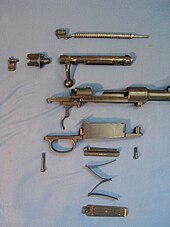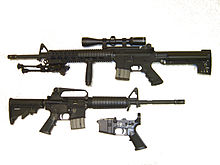Receiver (firearms): Difference between revisions
→'80 percent' receiver: rm complete nonsense. Nothing to do with "80 percent" and ATF reviews them to see if any work for the fire control group is done. An AR casting with a single 0.154" trigger pin hole is a firearm. |
No edit summary |
||
| Line 1: | Line 1: | ||
[[File:Disassembled mauser long action.jpg|thumb|upright|Disassembled Mauser action showing partially disassembled receiver and bolt]] |
[[File:Disassembled mauser long action.jpg|thumb|upright|Disassembled Mauser action showing partially disassembled receiver and bolt]] |
||
{{refimprove|date=March 2013}} |
{{refimprove|date=March 2013}} |
||
In [[firearms terminology]], the '''receiver''' is the part of a [[firearm]] that houses the operating parts. There are many types and styles of firearm receivers. A [[bolt action]] or [[semi-automatic firearm]] receiver usually contains the [[bolt (firearms)|bolt]] carrier group, [[trigger (firearms)|trigger]] group, and magazine port. |
In [[firearms terminology]], the '''receiver''' is the part of a [[firearm]] that houses the operating parts. There are many types and styles of firearm receivers. A [[bolt action]] or [[semi-automatic firearm]] receiver usually contains the [[bolt (firearms)|bolt]] carrier group, [[trigger (firearms)|trigger]] group, and magazine port.<ref>{{Cite web|url=http://www.opticsplanet.com/howto/how-to-how-to-build-an-ar15-lower-receiver.html|title=How to build an AR15 Lower Receiver|access-date=2016-08-05}}</ref> |
||
[[File:Stag2wi.jpg|thumb|[[AR-15]] rifles showing their configurations with different upper receivers (stripped-down lower receiver is visible at bottom)]] |
[[File:Stag2wi.jpg|thumb|[[AR-15]] rifles showing their configurations with different upper receivers (stripped-down lower receiver is visible at bottom)]] |
||
Revision as of 20:48, 5 August 2016

This article needs additional citations for verification. (March 2013) |
In firearms terminology, the receiver is the part of a firearm that houses the operating parts. There are many types and styles of firearm receivers. A bolt action or semi-automatic firearm receiver usually contains the bolt carrier group, trigger group, and magazine port.[1]

In most handguns, the receiver, or frame, holds the magazine well or rotary magazine as well as the trigger mechanism. It is sometimes called the body of the firearm, while in the context of handguns (revolvers and pistols), it is often called the frame.
The receiver is often made of forged, machined or stamped steel or aluminium; in addition to these traditional materials, modern science and engineering have introduced polymers and sintered metal powders to receiver construction.[2]
In US law
Under United States law, the receiver is the actual firearm itself,[3] and as such it is the controlled part (without which operation is impossible). Generally, the law views the receiver as that part of a firearm housing that has the serial number upon it. Thus, in the case of a firearm that has multiple receivers (such as the AR-15, which has an upper and lower receiver), the legally controlled part is the one that is serialized (the lower, in the AR-15's case).
References
- ^ "How to build an AR15 Lower Receiver". Retrieved 2016-08-05.
- ^ "HK416 modular assault rifle / carbine / upper receiver assembly (Germany)". Retrieved 5 Aug 2010.
- ^ "Firearms - Frequently Asked Questions - Firearms Technology | ATF". Archived from the original on 3 May 2015. Retrieved 7 June 2015.
